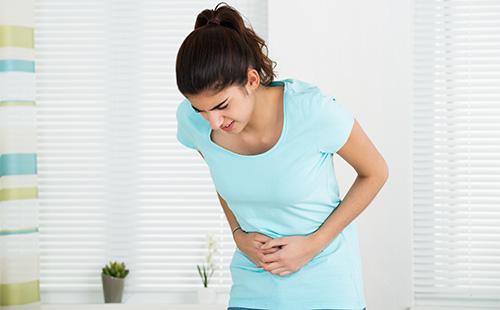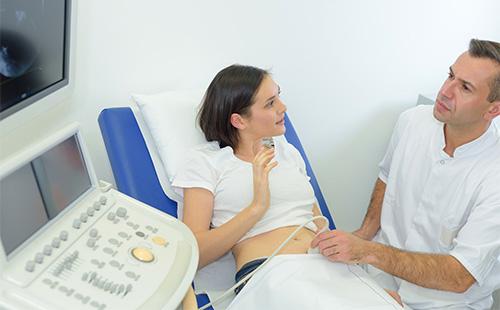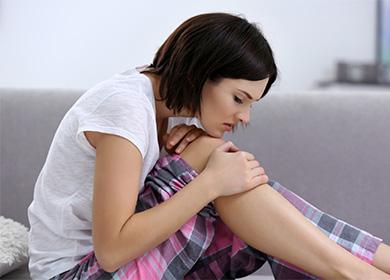The content of the article
The synonyms of the name of this suffering are algomenorrhea, dysmenorrhea. According to ICD-10 it is classified as N94. Some women literally "sit" on painkillers and cannot get out of bed during critical days, and during the examination they hear: "You are healthy." Could this be? What is the cause of violations and how to deal with the situation?
What is algodismenorea and classification of pathology
Dysmenorrhea can occur from the menarche period - the formation of menstruation. But more often girls begin to notice the appearance of painful menstruation by the age of 17-19. The classification of pathology is as follows:
- primary (spasmodic) - pain is not associated with other diseases, it occurs as a result of a malfunction in the hypothalamus-pituitary-ovary-uterus system, as well as due to abnormal prostaglandin biosynthesis;
- secondary (organic) - occurs against the background of other diseases, for example, with endometriosismyoma.
Depending on the severity of the pain syndrome, it is customary to distinguish three stages of dysmenorrhea. The data are presented in the table.
Table - Determination of the degree of algodismenorea
| Sign | 1 degree | 2 degree | 3 degree |
|---|---|---|---|
| Pain intensity | Mild soreness | Moderate | Strong |
| Do I need analgesics | Seldom | Is always | Yes, repeatedly |
| Is there any loss of performance | Not | Partial | Full |
| Other symptoms | Not expressed | Are present | Pronounced |
Primary dysmenorrhea ...
Until the end, the pathophysiological aspects of primary dysmenorrhea have not been established. It is believed that a violation of the relationship between the hypothalamus, pituitary and genital organs leads to an imbalance of hormones. This entails an increase in prostaglandins, oxytocin and other active substances. All of them stimulate uterine contractions, leading to muscle spasm, irritation of nerve endings and thereby increase sensitivity.
A special role is given to prostaglandins, the level of which increases in the second phase.
If the balance between estrogens and gestagens is disturbed, their increased formation occurs. This entails the appearance of pain. Prostaglandins affect not only uterine tissue, but also other organs. It causes systemic reactions, such as headache, dizziness, nausea, fainting.
Primary dysmenorrhea often occurs in girls of asthenic physique, with low body weight, with autonomic dysfunctions, in impressionable.
... and secondary
In women of an older age group, the causes of algodismenorea can be hidden in other diseases. Most often, pain during menstruation gives the following conditions.
- Uterine fibroids. Soreness is noted with large tumors (more than 4-5 cm), with a subserous location, with malnutrition of fibromyoma, as well as with a "born" node.A woman notes pulling pains in the lower abdomen, in the lower back without a clear localization.
- Endometrioid foci. Any localization of endometriosis leads to pain, with the exception of the location on the cervix. When the pelvic peritoneum is involved in the process (even by 1-2 mm), the woman feels pulling pains, and when the proliferation is located in the utero-rectal recess, acute “dagger” in the perineum.
- Ovarian formation. Tumors lead to compression of the tissues, irritation of the nerve endings. Pain can occur during sexual intercourse and in certain positions. Small formations can be asymptomatic.
- Genital malformations. The presence of a septum in the cavity, complete or partial doubling of organs leads to abnormal contraction of the uterus, causing pain.
- Adhesion process. It is formed after the transmitted inflammation of the genital organs, as well as after surgical interventions, for example, removal of the cyst, ectopic pregnancy, myomatous nodes, after cesarean section.
- Genital inflammation. At the same time, women noted pain throughout the cycle, but their intensification precisely during menstruation. Complaints of copious discharge and their unpleasant odor also accompany.
- Installed Navy. A foreign body causes a chronic aseptic inflammatory reaction and an increase in the content of prostaglandins in the myometrium. This entails excessive contractile activity and pain. In addition, unpleasant sensations can occur with a displacement of the IUD or its partial loss, during menstruation this happens more often due to some opening of the cervical canal.
Women suffering from algodismenorea are prone to hypochondria, depression, and hysteria. Often they reject thoughts of menstruation. Such disturbances in the functioning of the central nervous system are, inter alia, a consequence of an imbalance of sex hormones and impaired prostaglandin synthesis. Secondary dysmenorrhea often occurs in women after 35-40 years old against the background of existing gynecological pathology.
Symptoms
Despite the variety of causes and the pathogenetic mechanism of pain development, the symptoms of algodismenorea in women are similar.
Pain
This is the main complaint for dysmenorrhea. For pain, you can choose the following characteristics:
- arise - on the eve of menstruation or in the first 24-48 hours;
- the most painful - first days;
- character - sharp or dull, paroxysmal;
- are localized - more often in the lower abdomen, below the navel;
- there may be back pain - as well as the sacrum and lower back.
Other manifestations
Signs of algodismenorea in women include complaints from the autonomic nervous system, disruption of the endocrine system and psychoemotional status.
- Mental disorders. Irritability, tendency to depression, sleep disturbance, change in taste preferences and a special perception of odors.
- Exchange-endocrine symptoms. Women note general weakness, “cotton legs”, swelling of the face and entire body, itching of the skin, an increase in the frequency and volume of urination.
- Vegetative disorders. These include disorders of the stool (diarrhea or constipation), dry mucous membranes, bloating, frequent urge to defecate and urinate, nausea, vomiting, sensation of sensation, excessive sweating.
- Vegetative changes. Headache and even migraines, impaired sensation of the type of paresthesia ("goosebumps"), pain in the heart and a feeling of interruptions in his work, blood pressure drops.
When urgently to a doctor
Usually, girls with painful periods know in advance what to expect. But the following situations should alert and become an occasion to see a doctor:
- there were no such pains before;
- it is known that there are tumors (ovarian cysts);
- dizziness, weakness progresses, pressure drops;
- pains against the background of copious spotting.
Survey
Diagnosis of algodismenorea in women follows by eliminating organic diseases and the pathology of other systems and organs. For this, it is recommended to undergo the examinations indicated in the table.
Table - The necessary diagnostic measures for dysmenorrhea
| Survey | Why do you need | When to do |
|---|---|---|
| Gynecologist examination | - To exclude volume formations; - for taking smears; - to formulate a further treatment plan | On the 5-20th day of the menstrual cycle |
| Ultrasound scan | Allows to suspect / detect tumors, structural abnormalities, adhesions, inflammatory process | For 7-10 days of the cycle |
| CT or MRI | To clarify the presence of tumors or abnormal structure of the genitals | Any day of the cycle |
| Hysteroscopy | Used for suspected pathology inside the uterine cavity (fibroids, polyps, adenomyosis) | In the first half of the cycle |
| Laparoscopy | - In unclear cases; - when planning surgical treatment | In the first half of the cycle |
| STI screening | It is necessary to exclude the inflammatory process | After the complete end of menstruation any day |
Seizure treatment
A woman should know how to relieve pain with algodismenorea. In any case, you do not need to tolerate it. For the relief of seizures, the drugs presented in the table are used. It is impossible to say unequivocally which one will help. “Find your own” is necessary through “trial and error”, strictly observing the dosage and compatibility of drugs.
Table - Painkillers for dysmenorrhea
| Active substance | The commercial name of the drug | Dosage regimens and doses |
|---|---|---|
| Papaverine hydrochloride | "Papaverine" | - Tablets: 20-40 mg 2-3 times a day; - with intravenous or intramuscular administration up to 200 mg / day; - one candle 2-3 times a day |
| Drotaverine hydrochloride | - “No-shpa”; - "Drotaverin"; - "Spazmol"; - "Spazmonet" | - Tablets: 40-80 mg 2-3 times a day; - intravenously or intramuscularly up to 240 mg / day |
| Ketorolac | - “Ketanov”; - Ketorol | - One tablet, not more than 90 mg / day; - intramuscularly or intravenously, 10-30 mg every 6-8 hours |
| Diclofenac | - "Voltaren"; - "Dicloberl"; - "Naklofen" | - Tablets: 50 mg 2-3 times a day; - 75 mg intramuscularly every 12 hours; - rectal suppositories: 50 mg every 8 hours |
| Metamizole sodium | - “Analgin”; - "Baralgin" | - Intravenously or intramuscularly no more than 2 g / day (4 ampoules); - tablets: 500 mg up to 4 times a day |
| ASK | Aspirin | Tablets: 500 mg twice daily |
| Ibuprofen | - “Ibuprofen”; - “Burana”; - "MIG"; - Nurofen | - Tablets: one 3-4 times a day, no more than 1000 mg / day; - candles: one 60 mg every 4-6 hours |
| Indomethacin | - “Indomethacin”; - Metindol | - Tablets: one 25 mg 1-2 times a day, not more than 100 mg; - rectal suppositories: one 1-2 times a day |

Pain prevention
For the long-term effect and prevention of pain, the following groups of drugs for continuous use are subsequently used.
- Soothing. The most commonly used alcohol solution or valerian tablets, Seduxen, drugs from the antidepressant group. They help to establish connections between the departments of the central nervous system and thereby reduce the pain threshold.
- Oral contraceptives. These are one of the effective drugs that are most often used in treatment regimens for algodismenorea in women. They are selected taking into account the phenotype and hormonal profile. Assigned, for example, "Jess", "Dimia", "Regulon", "Novinet."
- Gestagens. Given that the deficiency of this particular group of hormones causes excessive production of prostaglandins, it is effective to prescribe isolated progestogen preparations to relieve pain. For example, Duphaston, Utrozhestan, Norkolut.
- Magnesium Orotat. Magnesium is involved in the process of contraction and relaxation of muscle fibers, in the transmission of a nerve impulse. Trace deficiency leads to spasm and pain. Therefore, women with dysmenorrhea are advised to regularly drink magnesium-based drugs.
- Enzyme therapy. Used for adhesions, endometriosis. Popular drugs - Wobenzym,Longidaza».
- Anti-inflammatory treatment. It is prescribed for active infections, including genital. Drugs from the group of antibacterial agents are used taking into account the identified pathogens.
If organic diseases (for example, endometriosis, fibroids, ovarian cysts) are detected, pain can be eliminated during menstruation only through surgical treatment - hysteroscopy, laparoscopy or abdominal surgery.
Non-drug treatments
To prevent new attacks or reduce the intensity of the pain syndrome, folk remedies and physiotherapy can be used. The following methods have proven high efficiency:
- acupuncture;
- hirudotherapy;
- electrophoresis with novocaine or with magnesium;
- acupressure.
ethnoscience
Herbal preparations have anti-inflammatory, analgesic and sedative effects. Recipes are easy to reproduce at home. And the reviews of women confirm their high efficiency.
- Root elecampane. It is necessary to take the root and grind it. Then pour one teaspoon in a glass of boiling water, let it brew for half an hour. Take a tablespoon twice a day during menstruation.
- Horsetail. To prepare the solution, you need to take a tablespoon of horsetail, pour two glasses of boiling water. Soak for two to three hours. Take a quarter cup every hour until the pain decreases.
- Strawberry leaves. For cooking, you should take forest strawberries, not garden. Grind the leaves, pour one tablespoon of 200 ml of hot water. Allow to stand for 30-60 minutes, take half a glass two to three times a day.
- Valerian with mint and camomile. Take valerian and mint grass in equal shares, and twice as much chamomile flowers. To mix. Take a tablespoon of the mixture and pour a glass of boiling water. Let it brew for 30 minutes, drink two tablespoons two to three times a day during menstruation.

Is it possible to avoid
Algodismenorea, if this is the primary form, does not have serious complications, in addition to the psycho-emotional stress of the girl in anticipation of menstruation. Secondary dysmenorrhea can be complicated by infertility, acute surgical pathology, and inflammatory processes. In any case, it is important to prevent the disease. The main recommendations are as follows:
- healthy sleep for at least six to eight hours;
- physical activity;
- pregnancy and lactation;
- psycho-emotional calm;
- sexual literacy;
- regular examination by a gynecologist.
Dysmenorrhea, according to some reports, occurs in eight out of ten girls of reproductive age. You can cope with pain only with a specialist - a doctor will help identify the cause and prescribe drugs. Treatment of algodismenorrhea consists of the relief of attacks of pain, as well as schemes to prevent future episodes.
Reviews
I know what is it! And pain and vomiting ... It only helps ketans. If I don’t drink it, then everything can be shot1 The pain is just hellish, unbearable! You can neither sit down, nor lie down, nor stand. You just run around the apartment in shock and suffer from pain.Doctors advised drinking Remenz. So I’ll go buy, I’ll try and then unsubscribe.
Bee, http://www.woman.ru/health/woman-health/thread/3914837/
I used to get very sick very much, I could barely walk, no spazgans helped. once I couldn’t get out of bed in the morning, I got in and fainted, and so 3 times, I drank spazgan 2 tablets, it did not help. it’s good that my mother was near, she gave me an injection of noshpa and everything went well, not a pill, but an injection. then she drank ok for almost 2 years, nothing hurt, now I haven’t been drinking it for almost a year, it hurts quite a bit, I don’t even need to drink a pill. still helps if the husband massages the lower back, don’t know how but helps
A guest, http://www.woman.ru/health/woman-health/thread/3914837/
My periods began at the age of 13 and still (I am now 20) are very painful. Very strong undulating pain in the lower abdomen, legs give way. If you do not lie down quickly, your head becomes dizzy. All this is accompanied by loose stools, which forces one to get out of bed. After a while, she begins to feel sick - taking tablets is useless, the body throws them back. Although they do not help. I drank everything that was possible from painkillers. The gynecologist said that the organs are all right
Eugene, http://www.sikirina.tsi.ru/forum/menstruaciya-narusheniya-menstrualnogo-cikla/silnie-boli-pri-menstruacii1.html
So before my birth, my stomach was very sick before my periods, but not every month, but after about a month, but after giving birth I don’t remember about these pains at all. Looks like a hormonal change occurs in the body after childbirth, which contributes to the painless transfer of critical days.
Irik http://detstvo.ru/forum/pro-eto/5575-vo-vremya-mesyachnyh-silno-bolit-zhivot-chto-delat.html
I totally agree. I also suffered with a bend of the uterus. They even took me away a couple of times, she lost consciousness from pain. And then she passed, although the bend remained. Later, in smart books, she read out that for many menstrual pains are so strong due to psychological problems (the so-called psychosomatic pains), this may be due to the denial of awareness of one's own femininity, the desire to become pregnant, and giving too much importance to one's “expectations” of menstruation (they will begin soon , I’ll freak out again, etc.) and even from the relationship with a man who is close by and having sex with him ... .. I don’t know how seriously you can take this, but my pain almost stopped yes, when the “same” man appeared in my life. Here it is.
Dr.Queen, http://detstvo.ru/forum/members/88728-dr-queen/

